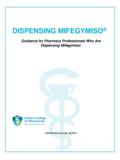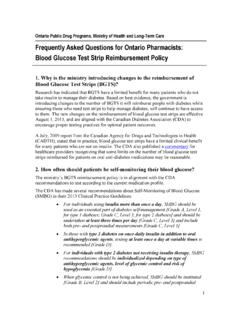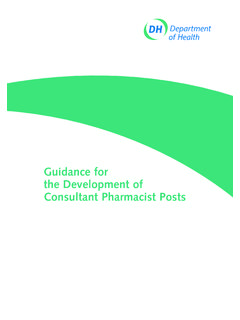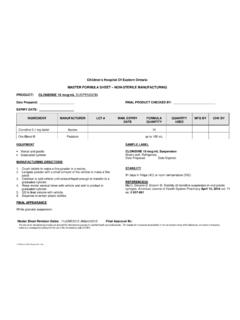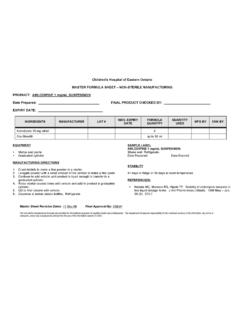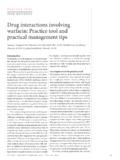Transcription of Antimicrobial Stewardship A Certificate Program for ...
1 1 Antimicrobial Stewardship A Certificate Program for pharmacists Certificate Program Description and Audience The Antimicrobial Stewardship Certificate Program is an innovative and intensive practice based activity for pharmacists focusing on the pharmacist's role in the area of appropriate use of Antimicrobial agents. The Program , which emphasizes a health care team approach, seeks to foster the development of a strong knowledgebase in microbiology, pharmacology and disease state management in order to successfully implement an Antimicrobial Stewardship Program that will improve patient care, reduce healthcare expenditures and potentially reduce rates of resistance and prolong the longevity of the limited number of Antimicrobial agents available to treat infections.
2 Established in 2010, the SIDP Antimicrobial Stewardship Certificate Program has been a resource for pharmacists world wide in meeting their educational needs for Antimicrobial Stewardship . Antimicrobial Stewardship Certificate Program Development The Antimicrobial Stewardship Certificate Program was developed by members of The Society of Infectious Diseases pharmacists (SIDP). All members volunteered their time and knowledge in developing the content of this Program . There was no outside financial support for developing this Program . Antimicrobial Stewardship Certificate Program Goals The Certificate Program goals/learning objectives are the following: 1. Outline the essentials of clinical microbiology, pharmacology, pharmacokinetics, pharmacodynamics, and infectious disease state management necessary in Antimicrobial Stewardship .
3 2. Identify the skills needed to establish an Antimicrobial Stewardship Program . 3. Implement interventions to improve patient care, minimize resistance and cost, and prolong the longevity of antimicrobials through a cap stone project. 4. Explain how to evaluate the effectiveness of an Antimicrobial Stewardship Program through the measurement of outcomes. 5. Define the interaction between pharmacy and infection control. Antimicrobial Stewardship Certificate Program Structure The Antimicrobial Stewardship Certificate training Program is conducted in three parts. Each part must be completed prior to starting the next one. Phase 1. Self study learning component available online (approx. 3 months) Phase 2. Live webinars (approx. 5 months) Phase 3. Skills component completed in the practice setting (approx.)
4 4 months) A Certificate of Achievement will be awarded to participants who successfully complete all three Program components. Participants who successfully complete the Program will be eligible for a 1 year free associate membership in SIDP. Self Study Learning Component (Phase 1) The first component of the Certificate training Program consists of seven sections of self study modules available for viewing online. Topics, learning objectives, and length of time to complete each self study module are noted on the outline below. ProCE, Inc. 848 W. Bartlett Road Suite 11E Bartlett, IL 60103 2 Module 1 Microbiology 1a Staphylococcus species (ACPE UAN: 0221 9999 17 329 H01 P, Knowledge based, contact hour, Release: 7/7/2017, Exp: 7/1/2023) Explain the Gram stain & morphology of various bacteria Discuss commensal flora in the body and where select organisms are pathogenic List agents with activity or should be considered for use against various organisms Discuss resistance issues associated with various organisms 1b Streptococcus & Enterococcus (ACPE UAN: 0221 9999 19 481 H01 P, Knowledge based, contact hour, Release: 9/15/2019, Exp.
5 3/15/2022) Explain the Gram stain & morphology of various bacteria Discuss commensal flora in the body and where select organisms are pathogenic List agents with activity or should be considered for use against various organisms Discuss resistance issues associated with various organisms 1c Non Fermenters (ACPE UAN: 0221 9999 18 089 H01 P, Knowledge based, contact hour, Release: 3/16/2018, Exp: 7/1/2023) Explain the gram stain and morphology of Acinetobacter, Pseudomonas, and Stenotrophomonas maltophilia Discuss the epidemiology of Acinetobacter, Pseudomonas, and Stenotrophomonas maltophilia List agents with activity or should be considered for use against Acinetobacter, Pseudomonas, and Stenotrophomonas maltophilia Discuss resistance issues associated with Acinetobacter, Pseudomonas, and Stenotrophomonas maltophilia and the roll of combination therapy 1d Enterobacteriaciae (ACPE UAN: 0221 9999 19 482 H01 P, Knowledge based, contact hour, Release: 9/15/2019, Exp.
6 3/15/2022) Discuss commensal flora in the body and where select organisms are pathogenic List agents with activity or should be considered for use against various gram negative bacilli Discuss resistance issues associated with various organisms 1e Haemophilus, Moraxella, Neisseria, Atypical Organisms (ACPE UAN: 0221 9999 19 483 H01 P, Knowledge based, contact hour, Release: 9/15/2019, Exp: 3/15/2022) Explain the gram stain and morphology of various bacteria. Discuss commensal flora in the body and where select organisms are pathogenic. Explain the various types of infections. List agents with activity or should be considered for use against various organisms. Discuss resistance issues associated with various organisms. 1f Anaerobes (ACPE UAN: 0221 9999 19 484 H01 P, Knowledge based, contact hour, Release: 9/15/2019, Exp: 3/15/2022) Explain the gram stain and morphology of various bacteria Discuss commensal flora in the body and where select organisms are pathogenic Explain the various types of infections List agents with activity or should be considered for use against various organisms Discuss resistance issues associated with various organisms 1g Fungi (ACPE UAN: 0221 9999 19 485 H01 P, Knowledge based, contact hour, Release: 9/15/2019, Exp.
7 3/15/2022) Recognize the differences between yeasts, molds, and dimorphic fungi Describe the activity of antifungals against key fungal pathogens Discuss challenges that are inherent to antifungal pharmacotherapy Module 2 Pharmacology 2a Antimicrobial Pharmacology I (ACPE UAN: 0221 9999 19 486 H01 P, Knowledge based, contact hour) 2b Antimicrobial Pharmacology II (ACPE UAN: 0221 9999 19 487 H01 P, Knowledge based, contact hour) 2c Antimicrobial Pharmacology III (ACPE UAN: 0221 9999 19 488 H01 P, Knowledge based, contact hour) Antimicrobial Pharmacology (I, II, III) learning objectives (Release: 9/15/2019, Exp: 3/15/2022): Explain the principals of anti infective pharmacology Describe the classifications of anti infectives including mechanisms of action, mechanisms of resistance, spectrum of activity, infections commonly treated, adverse effects (most common, very serious or unique), and drug interactions Select and discuss rationale for drugs of choice for various organisms Module 3 Pharmacokinetics/Pharmacodynamics 3a Pharmacokinetics Primer for Clinicians (ACPE UAN: 0221 9999 19 489 H01 P, Knowledge based, contact hour, Release: 9/15/2019, Exp: 3/15/2022) Describe pharmacokinetics (PK) and the clinical application of PK parameters in daily clinical practice.
8 Describe physiologic factors and disease states that affect drug disposition throughout the body. 3b Introduction to Antimicrobial Pharmacodynamics (ACPE UAN: 0221 9999 19 490 H01 P, Knowledge based, contact hour, Release: 9/15/2019, Exp: 3/15/2022) Discuss pharmacodynamics (PD) and the basic laws governing its application into clinical practice. Discuss the various in vitro, in vivo, and clinical testing methodologies used to derive PD breakpoints. 3 Demonstrate knowledge of the PD parameters that optimize the efficacy of each Antimicrobial agent and the published data used to derive the currently accepted PD breakpoints. Describe Monte Carlo Simulation (MCS), the rationale behind performing this analysis, interpretation of the results, and the limitations associated with these analyses.
9 3c Applied Antimicrobial Pharmacodynamics (ACPE UAN: 0221 9999 19 491 H01 P, Knowledge based, contact hour, Release: 9/15/2019, Exp: 3/15/2022) Describe Monte Carlo simulation (MCS), the rationale behind performing this analysis, interpretation of the results, and the limitations associated with these analyses. Provide examples that correlate data generated from MCS analyses and clinical outcome data generated from real patients. Evaluate unconventional dosing strategies used to maximize the pharmacodynamics (PD) of currently available antimicrobials. 3d Antifungal pharmacodynamics (ACPE UAN: 0221 9999 19 492 H01 P, Knowledge based, contact hour, Release: 9/15/2019, Exp: 3/15/2022) Describe pharmacokinetics (PK) and the clinical application of PK parameters in daily clinical practice.
10 Describe physiologic factors and disease states that affect drug disposition throughout the body. Discuss pharmacodynamics (PD) and the basic laws governing its application into clinical practice. Discuss the various in vitro, in vivo, and clinical testing methodologies used to derive PD breakpoints. Demonstrate knowledge of the PD parameters that optimize the efficacy of each Antimicrobial agent and the published data used to derive the currently accepted PD breakpoints. Evaluate unconventional dosing strategies used to maximize the PD of currently available antimicrobials. Examine the rationale supporting therapeutic drug monitoring for available antifungal agents. Module 4 Disease States and Treatments 4a Bone & Joint Infections (ACPE UAN: 0221 9999 18 088 H01 P, Knowledge based, contact hour, Release: 3/14/2018, Exp: 7/1/2023) Categorize joint infections septic arthritis and prosthetic joints Identify patient presenting symptoms.


